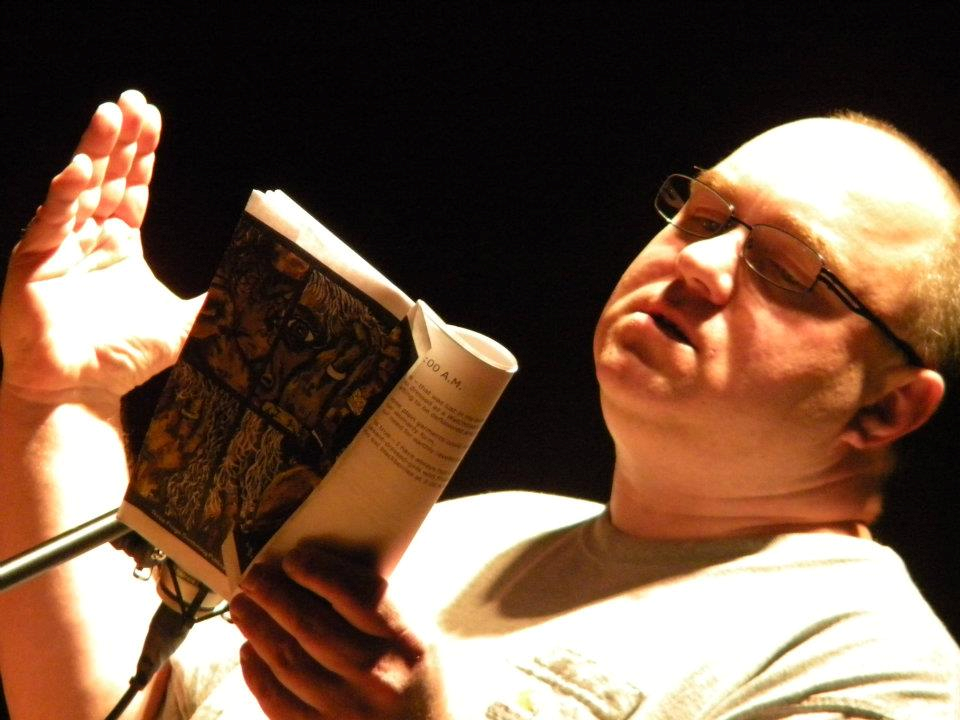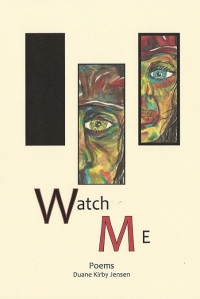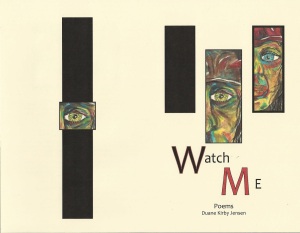Duane is the recipient of the 2013 Mayor’s Arts Award for Artistic Excellence & Contribution to Everett’s Cultural Vitality, a publisher at Three Frogs Swimming Publications, the host of Everett Poetry Nite, that meets every Thursday night, a painter and a poet. His sixth poetry book “Watch Me” was recently released. I had a chance to talk with him about his life as an artist.

There is an old Latin proverb, “Still waters run deep.” I often think of this saying when I encounter Duane. His naturally peaceful nature houses a deep intellect and stirring passion. Quite simply, he is absolutely stimulating to converse with and I am all the better knowing him.
About his art, his web site, The Art of Duane Kirby Jensen, says it best, “His work evokes those places which linger beneath the surface underscoring the narrative of being, the fragility of identity, the gravity of emotion and the ease in which it can be lost.”
Here is my interview with Duane.
Congratulations on your book of poetry “Watch Me.” Tell me more about it.
This is my first concept book of poetry. It is the story of him and her and their quirky love story. It is laid out to be read from beginning to end so one can experience the full arch of their story.
I have steered away from giving them an identity as defined by names and detailed background. Instead we watch their emotions ebb and flow and explore the fragility their internal identities can be. That identity.
These poems are also playful and extremely sexy. When I have read them at venues around Western Washington, I have had women ooh and awe through the reading, then preposition me after the reading.
Your poems are mysterious, nicely knitted works. What does your writing process look like?
The short answer is, each poem is written within the process it needs.
That being said, let me share with you a more detailed answer I gave on January 2, 21014, when I featured at the Hibulb Cultural Center & Natural History Preserve:
I do not have a set process. A poem can be launched by a word, a phrase, a comment I make on Facebook. My mind is always working on things – both in terms of paintings and poems, until they have gestated long enough and are ready to burst forth.
I am always creating. Painting and poetry feed off each other. There is always something ripening, ready to be plucked and made real.

© 2014 By Duane Kirby Jensen,
9 x 12 inches (22.9 cm x 30.5 cm) ink on claybord
Most of my poems are written with pen and paper before they get inputted into the computer. The computer itself has eased the burden of my dyslexia. If I was still stuck using my old Smith-Corona typewriter, my poetic output – at least publicly, would be at a fraction of itself.
The strength of my writing is due to two things: – I have a wide ranging mind that looks at things from angles that are askew of the norm and editing. Editing is the moment I refine and tighten my vision. I love editing. It has allowed me to present my work in the form I want it to be seen and heard. It is also the moment when many poems are born.
Often I have had great lines or words that carry an impact, but within the poem of their birth, they are no better then weeds clogging up the flow of the poem.
So I transplant them into my folder of “Poetic Possibilities”. In time most of these lines develop into a new poem or poems.
Sometimes a poem will have many possible narrative lines. To follow each of them would create a mess. So three or four poems can emerge from the same seed.
Editing is where I can elevate my work. Push words and ideas until they sound unique and evocative. Where I can rip myself bare and let the reader see how the writer bleeds.
I’ve been to your home/art studio, Duane. Your walls are covered in an impressive art collection, original work by artists you encounter on your travels, and your own pieces. Where does your muse live?
The muse exists in the act of living. It is the way I see and interpret the world around me. I have so many ideas in my head, a back load of ideas to birth, it would take a dozen artist/writers a dozen lifetimes to achieve them all.
When I have talked about this with friends, they have asked, “Don’t you feel overwhelmed.” My answer has always been “No.” Explaining that as long as I just keep creating and only focusing on a handful of projects at a time, I can just keep creating. It is this process that keeps me excited. If I ever truly stepped back and surveyed that vastness – it might swallow me whole, leaving me a babbling blob of madness hiding in a brightly-lit corner.
If you don’t write every day, do you feel guilty?
Guilty? Never. The art of creation takes many forms. For me it is split between painting and writing. Some days the most important thing to do is nothing. Doing nothing, or more precisely producing nothing might be the most valuable thing a creative person can learn.
The Hibulb Cultural Center & Natural History Preserve asked me a similar question, and that answer bookends the above answer nicely.
The most honest thing I could say here is that I create twenty-four hours a day, seven days a week. From that, I must carve out time to work, eat and do the mundane things of life. But even as I do these things my mind is painting and repainting images with a variety of colors and textures – or writing and rewriting lines – each waiting their time to be birthed onto canvas or paper. And yes, sometimes there are internal arguments about who gets birthed first. Once I am at my desk, images flow out effortlessly into a pattern that I have already completed through much internal editing.
Many people have asked me, “Aren’t you afraid of forgetting your ideas?” Not really. The majority of my work is narrative based; meaning I am a story teller. As long as I can create one good narrative within my memory, when I sit down to write, or paint, the rest of the lines or images, will just fall into place.
If you see me looking distracted at times, it is because I am wrapped within my creative process. Envisioning images and words that will soon find a tangible life on canvas or paper.
Just as your book inspires authors, what authors have inspired you?
It is not just writers that inspire my writing, but painters: Matilde Alonso, Jean-Michel Basquiat, Lusican Freud, Edward Hopper, William Kentridge, Edvard Munch, Yves Tanguy and Dorothea Tanning. I try to capture what they do visually, and trap them inside poetry. I am always striving to create a narrative.
The writers include:
Raymond Carver, Hemingway and Sam Shepard grounds me. Rereading them keeps my lines clean.
Italio Calvino, Neil Gaiman, Haruki Murakami and Lucius Shepards spur the imagination through their manipulation of language and their ability to see what others are unable to see or comprehend.
Tim O’Brien is all about truth mixed with the mysticism, something that is only possible when a person has seen too much.
Pete Fromm: For the way he handles the short story form.
What poets do you continually go back to?
Yehuda Amichai (when translated by Chana Block and Stephen Mitchell): What he can do with words and with brevity is amazing. His words drip with emotion.
Cristin O’Keefe Aptowicz: I love the way she incorporates humor into her work, even when her words turn dark and she shows us how she bleeds.
Charles Bukowski: Since I begun reading Keats, Shelley and Byron in the 4th grade, my writing took on a flower flavor. Once and a while I still drift off into the old language. Bukowski reminds me to write in a modern tongue and that tongue has no limitations.

Martin Espada: The newest poet to my list, I have devoured his words over the past two years. His words ignite my rebellious spirit. His words feel like home.
Sandra Cisneros: Like Rodriques and Espada she writes from where she comes from, and the difficulty of breaking loose from the gender based expeditions she chaffs at.
Linda Pastan: An amazing poet. Her poems transport me to the moments being revealed.
Luis J. Rodriques: I love how he narrates his life and the environment he grew up in.
Jane Shore: She writes beautifully. She explores family and those small moments that carry unsuspecting eight.
Do you have a writing group or community of writers you share your work with?
Not really. For myself, I find writers group stifling and unproductive. I do have an editing group I am apart of, but the heaviest and most brutal edits are at my own hands.
What is your background? Where are you from?
I am a painter and a poet. I was initially inspired to paint as a child while watching my grandmother and grandaunt paint scenes of their Stanwood, WA community. I also come from a long line of painters, photographers, carvers, inventors and storytellers. I split my time between living in the city and working on my grandparents farm. My affinity for the land, as a means of growing food, and the land as a thing of beauty, seeps into my words and my art. As does the hustle and bustle of city life. The mix of constant motion and sound with that of patience and forethought. It makes me a man of two worlds and a resident of none.
What are you up to when you’re not writing?
When I am not writing, I am painting. Or I am deep in some form of creative enterprise. I read at poetry events throughout the northwest. I also have art expeditions throughout the region. I feel everything I do is interconnected.
Poison: His Fantasy
by Duane Kirby Jensen
I walked up to the bar,
ordered my second whiskey,
noticed she was drinking rum.
She was temptation
embodied within a cinnamon scent,
beautiful white teeth and huntress hips
that transformed men into moths.
I sipped my honey-colored liquor,
glancing into her brown eyes.
My blues lingered with the gentleness
of a hummingbird
seeking forbidden nectar.
“I am poison to men,” she volunteered,
with the confidence of a seasoned predator.
“I am immune to poison.”
I smiled.
“Let me taste your tears.”
“What tears,” she responded
through puzzled lips.
“The tears you will shed
if you don’t wake up with me at sunrise.
The tears you will shed
if you don’t taste my buttermilk biscuits
which I would bake for you from scratch.
The tears you will shed
when you realize your abandonment issues
are self inflicted.”
Intrigue enlarged her enormous brown eyes,
that were suddenly sparkling
as if filled with a burst of carbonation.
She said, in a hushed breath,
“You’re a very dangerous man.”
My hand reached around the back of her head,
dissolving into her long black hair
which compelled me think of Rapunzel.
Her hair was thicker and darker
then an old growth forest on a moonless night.
I pulled her close for a long kiss,
saying “You have no idea how right you are.”
The bar felt silent.
Our lips parted without retreat.
“Do you want honey with your biscuits?” I asked.
“Yessss.” She purred.


